Mental Health Essay: Impact of Seclusion on Consumers and Staff
VerifiedAdded on 2022/08/21
|12
|3204
|13
Essay
AI Summary
This essay critically examines the impact of seclusion on mental health consumers and healthcare professionals. It defines seclusion and coercion, highlighting the negative physical and psychological consequences for patients, including distress, trauma, and physical injuries, while also acknowledging the challenges faced by healthcare staff, such as ethical dilemmas and moral conflicts. The essay then explores national and statewide initiatives, particularly the Australian government's efforts to reduce restrictive practices and the implementation of the Safewards model. The Safewards model emphasizes reducing conflict and improving nurse-consumer relationships. The registered nurse's role in collaborating with consumers, utilizing patient-centered approaches, and promoting calm-down methods is emphasized. The essay concludes by summarizing the adverse effects of seclusion and highlighting the importance of initiatives to decrease restrictive practices in mental health settings.
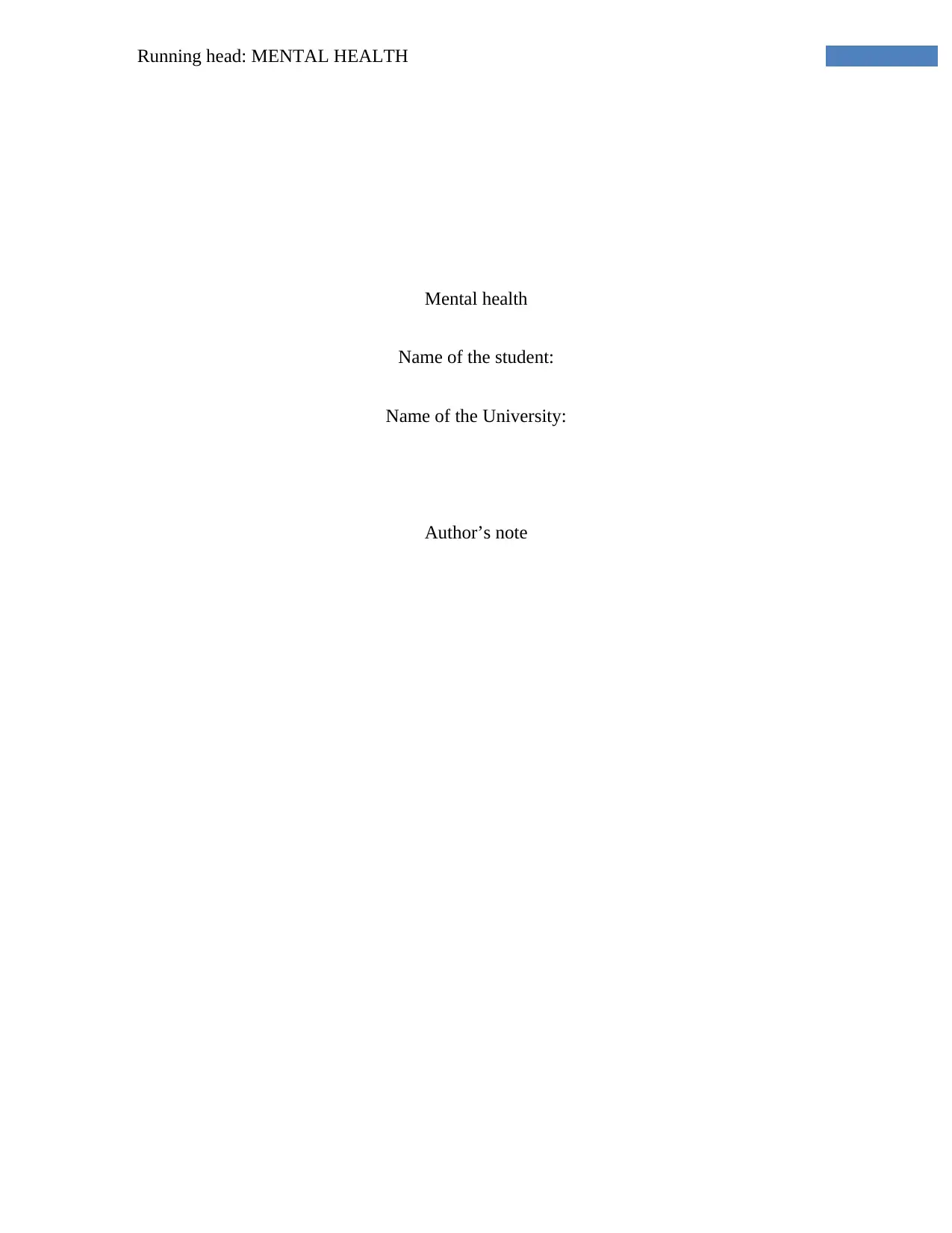
Running head: MENTAL HEALTH
Mental health
Name of the student:
Name of the University:
Author’s note
Mental health
Name of the student:
Name of the University:
Author’s note
Paraphrase This Document
Need a fresh take? Get an instant paraphrase of this document with our AI Paraphraser
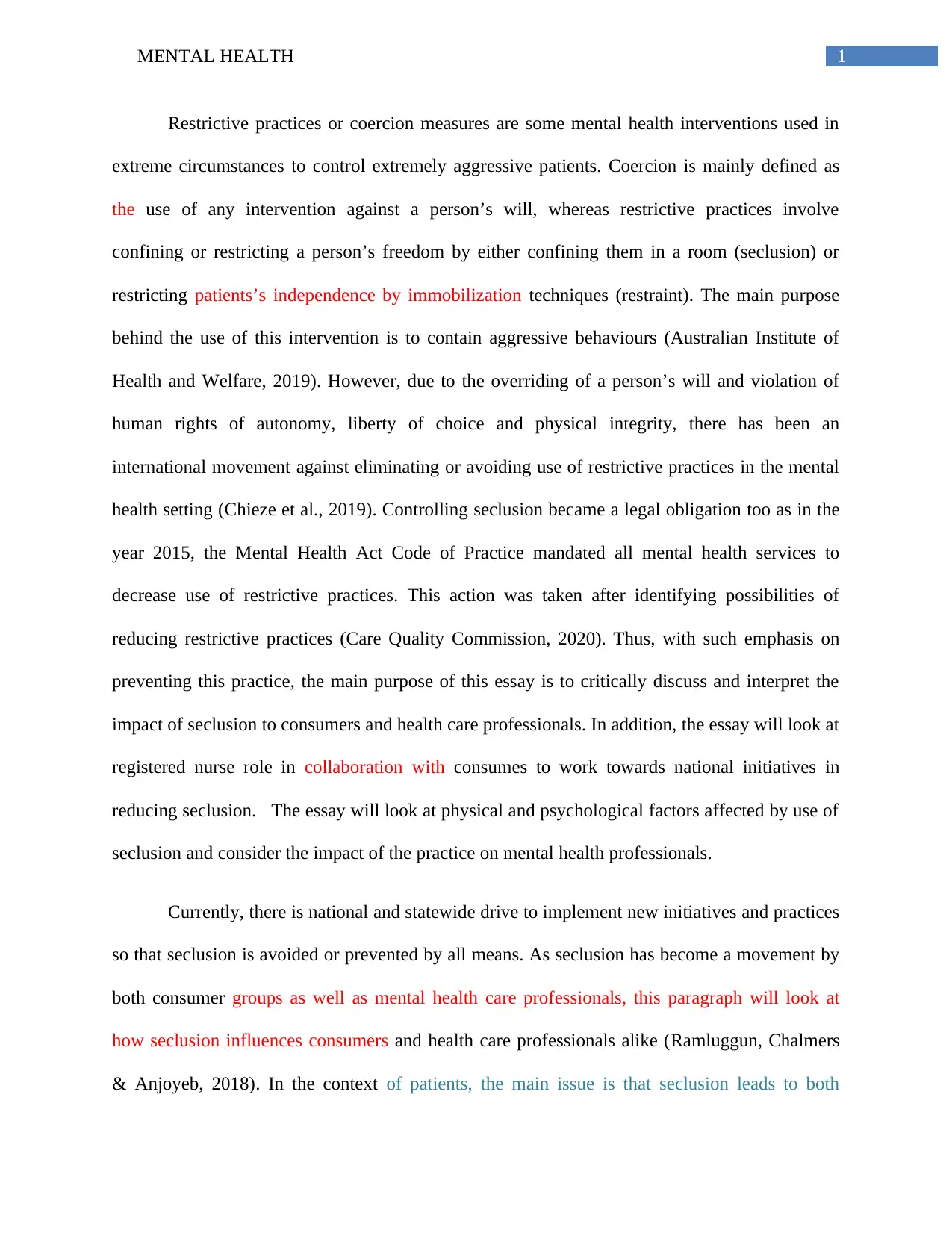
1MENTAL HEALTH
Restrictive practices or coercion measures are some mental health interventions used in
extreme circumstances to control extremely aggressive patients. Coercion is mainly defined as
the use of any intervention against a person’s will, whereas restrictive practices involve
confining or restricting a person’s freedom by either confining them in a room (seclusion) or
restricting patients’s independence by immobilization techniques (restraint). The main purpose
behind the use of this intervention is to contain aggressive behaviours (Australian Institute of
Health and Welfare, 2019). However, due to the overriding of a person’s will and violation of
human rights of autonomy, liberty of choice and physical integrity, there has been an
international movement against eliminating or avoiding use of restrictive practices in the mental
health setting (Chieze et al., 2019). Controlling seclusion became a legal obligation too as in the
year 2015, the Mental Health Act Code of Practice mandated all mental health services to
decrease use of restrictive practices. This action was taken after identifying possibilities of
reducing restrictive practices (Care Quality Commission, 2020). Thus, with such emphasis on
preventing this practice, the main purpose of this essay is to critically discuss and interpret the
impact of seclusion to consumers and health care professionals. In addition, the essay will look at
registered nurse role in collaboration with consumes to work towards national initiatives in
reducing seclusion. The essay will look at physical and psychological factors affected by use of
seclusion and consider the impact of the practice on mental health professionals.
Currently, there is national and statewide drive to implement new initiatives and practices
so that seclusion is avoided or prevented by all means. As seclusion has become a movement by
both consumer groups as well as mental health care professionals, this paragraph will look at
how seclusion influences consumers and health care professionals alike (Ramluggun, Chalmers
& Anjoyeb, 2018). In the context of patients, the main issue is that seclusion leads to both
Restrictive practices or coercion measures are some mental health interventions used in
extreme circumstances to control extremely aggressive patients. Coercion is mainly defined as
the use of any intervention against a person’s will, whereas restrictive practices involve
confining or restricting a person’s freedom by either confining them in a room (seclusion) or
restricting patients’s independence by immobilization techniques (restraint). The main purpose
behind the use of this intervention is to contain aggressive behaviours (Australian Institute of
Health and Welfare, 2019). However, due to the overriding of a person’s will and violation of
human rights of autonomy, liberty of choice and physical integrity, there has been an
international movement against eliminating or avoiding use of restrictive practices in the mental
health setting (Chieze et al., 2019). Controlling seclusion became a legal obligation too as in the
year 2015, the Mental Health Act Code of Practice mandated all mental health services to
decrease use of restrictive practices. This action was taken after identifying possibilities of
reducing restrictive practices (Care Quality Commission, 2020). Thus, with such emphasis on
preventing this practice, the main purpose of this essay is to critically discuss and interpret the
impact of seclusion to consumers and health care professionals. In addition, the essay will look at
registered nurse role in collaboration with consumes to work towards national initiatives in
reducing seclusion. The essay will look at physical and psychological factors affected by use of
seclusion and consider the impact of the practice on mental health professionals.
Currently, there is national and statewide drive to implement new initiatives and practices
so that seclusion is avoided or prevented by all means. As seclusion has become a movement by
both consumer groups as well as mental health care professionals, this paragraph will look at
how seclusion influences consumers and health care professionals alike (Ramluggun, Chalmers
& Anjoyeb, 2018). In the context of patients, the main issue is that seclusion leads to both
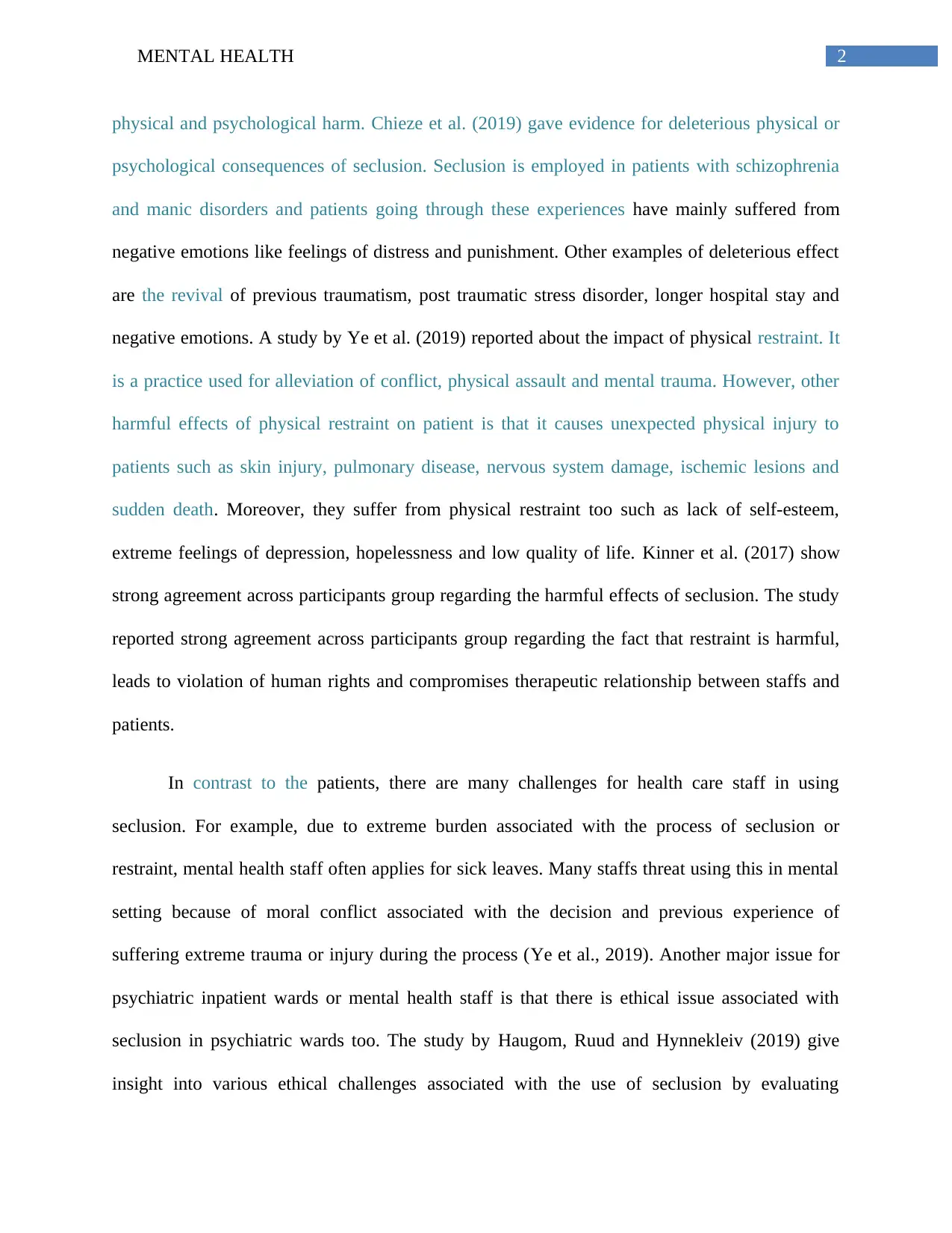
2MENTAL HEALTH
physical and psychological harm. Chieze et al. (2019) gave evidence for deleterious physical or
psychological consequences of seclusion. Seclusion is employed in patients with schizophrenia
and manic disorders and patients going through these experiences have mainly suffered from
negative emotions like feelings of distress and punishment. Other examples of deleterious effect
are the revival of previous traumatism, post traumatic stress disorder, longer hospital stay and
negative emotions. A study by Ye et al. (2019) reported about the impact of physical restraint. It
is a practice used for alleviation of conflict, physical assault and mental trauma. However, other
harmful effects of physical restraint on patient is that it causes unexpected physical injury to
patients such as skin injury, pulmonary disease, nervous system damage, ischemic lesions and
sudden death. Moreover, they suffer from physical restraint too such as lack of self-esteem,
extreme feelings of depression, hopelessness and low quality of life. Kinner et al. (2017) show
strong agreement across participants group regarding the harmful effects of seclusion. The study
reported strong agreement across participants group regarding the fact that restraint is harmful,
leads to violation of human rights and compromises therapeutic relationship between staffs and
patients.
In contrast to the patients, there are many challenges for health care staff in using
seclusion. For example, due to extreme burden associated with the process of seclusion or
restraint, mental health staff often applies for sick leaves. Many staffs threat using this in mental
setting because of moral conflict associated with the decision and previous experience of
suffering extreme trauma or injury during the process (Ye et al., 2019). Another major issue for
psychiatric inpatient wards or mental health staff is that there is ethical issue associated with
seclusion in psychiatric wards too. The study by Haugom, Ruud and Hynnekleiv (2019) give
insight into various ethical challenges associated with the use of seclusion by evaluating
physical and psychological harm. Chieze et al. (2019) gave evidence for deleterious physical or
psychological consequences of seclusion. Seclusion is employed in patients with schizophrenia
and manic disorders and patients going through these experiences have mainly suffered from
negative emotions like feelings of distress and punishment. Other examples of deleterious effect
are the revival of previous traumatism, post traumatic stress disorder, longer hospital stay and
negative emotions. A study by Ye et al. (2019) reported about the impact of physical restraint. It
is a practice used for alleviation of conflict, physical assault and mental trauma. However, other
harmful effects of physical restraint on patient is that it causes unexpected physical injury to
patients such as skin injury, pulmonary disease, nervous system damage, ischemic lesions and
sudden death. Moreover, they suffer from physical restraint too such as lack of self-esteem,
extreme feelings of depression, hopelessness and low quality of life. Kinner et al. (2017) show
strong agreement across participants group regarding the harmful effects of seclusion. The study
reported strong agreement across participants group regarding the fact that restraint is harmful,
leads to violation of human rights and compromises therapeutic relationship between staffs and
patients.
In contrast to the patients, there are many challenges for health care staff in using
seclusion. For example, due to extreme burden associated with the process of seclusion or
restraint, mental health staff often applies for sick leaves. Many staffs threat using this in mental
setting because of moral conflict associated with the decision and previous experience of
suffering extreme trauma or injury during the process (Ye et al., 2019). Another major issue for
psychiatric inpatient wards or mental health staff is that there is ethical issue associated with
seclusion in psychiatric wards too. The study by Haugom, Ruud and Hynnekleiv (2019) give
insight into various ethical challenges associated with the use of seclusion by evaluating
⊘ This is a preview!⊘
Do you want full access?
Subscribe today to unlock all pages.

Trusted by 1+ million students worldwide
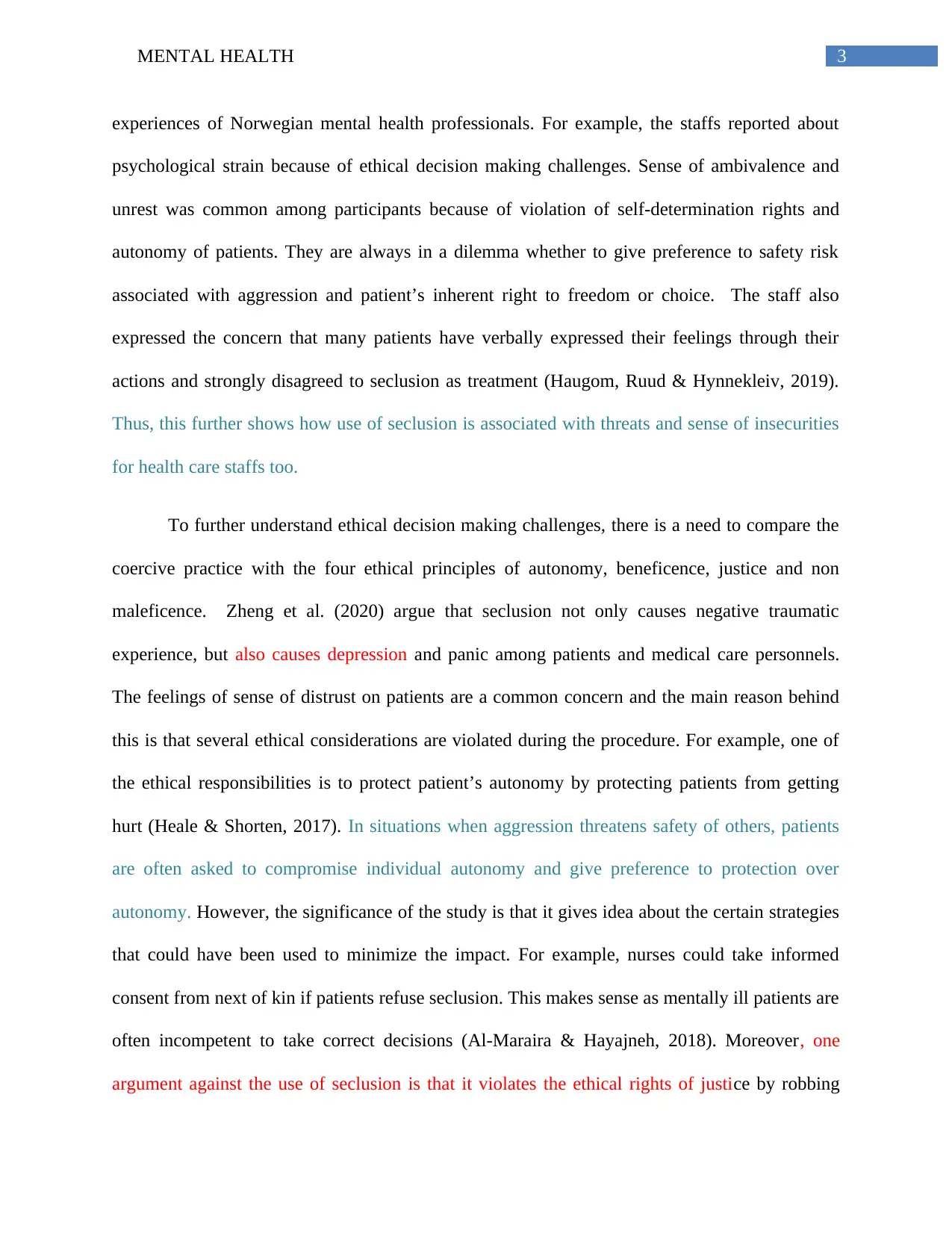
3MENTAL HEALTH
experiences of Norwegian mental health professionals. For example, the staffs reported about
psychological strain because of ethical decision making challenges. Sense of ambivalence and
unrest was common among participants because of violation of self-determination rights and
autonomy of patients. They are always in a dilemma whether to give preference to safety risk
associated with aggression and patient’s inherent right to freedom or choice. The staff also
expressed the concern that many patients have verbally expressed their feelings through their
actions and strongly disagreed to seclusion as treatment (Haugom, Ruud & Hynnekleiv, 2019).
Thus, this further shows how use of seclusion is associated with threats and sense of insecurities
for health care staffs too.
To further understand ethical decision making challenges, there is a need to compare the
coercive practice with the four ethical principles of autonomy, beneficence, justice and non
maleficence. Zheng et al. (2020) argue that seclusion not only causes negative traumatic
experience, but also causes depression and panic among patients and medical care personnels.
The feelings of sense of distrust on patients are a common concern and the main reason behind
this is that several ethical considerations are violated during the procedure. For example, one of
the ethical responsibilities is to protect patient’s autonomy by protecting patients from getting
hurt (Heale & Shorten, 2017). In situations when aggression threatens safety of others, patients
are often asked to compromise individual autonomy and give preference to protection over
autonomy. However, the significance of the study is that it gives idea about the certain strategies
that could have been used to minimize the impact. For example, nurses could take informed
consent from next of kin if patients refuse seclusion. This makes sense as mentally ill patients are
often incompetent to take correct decisions (Al-Maraira & Hayajneh, 2018). Moreover, one
argument against the use of seclusion is that it violates the ethical rights of justice by robbing
experiences of Norwegian mental health professionals. For example, the staffs reported about
psychological strain because of ethical decision making challenges. Sense of ambivalence and
unrest was common among participants because of violation of self-determination rights and
autonomy of patients. They are always in a dilemma whether to give preference to safety risk
associated with aggression and patient’s inherent right to freedom or choice. The staff also
expressed the concern that many patients have verbally expressed their feelings through their
actions and strongly disagreed to seclusion as treatment (Haugom, Ruud & Hynnekleiv, 2019).
Thus, this further shows how use of seclusion is associated with threats and sense of insecurities
for health care staffs too.
To further understand ethical decision making challenges, there is a need to compare the
coercive practice with the four ethical principles of autonomy, beneficence, justice and non
maleficence. Zheng et al. (2020) argue that seclusion not only causes negative traumatic
experience, but also causes depression and panic among patients and medical care personnels.
The feelings of sense of distrust on patients are a common concern and the main reason behind
this is that several ethical considerations are violated during the procedure. For example, one of
the ethical responsibilities is to protect patient’s autonomy by protecting patients from getting
hurt (Heale & Shorten, 2017). In situations when aggression threatens safety of others, patients
are often asked to compromise individual autonomy and give preference to protection over
autonomy. However, the significance of the study is that it gives idea about the certain strategies
that could have been used to minimize the impact. For example, nurses could take informed
consent from next of kin if patients refuse seclusion. This makes sense as mentally ill patients are
often incompetent to take correct decisions (Al-Maraira & Hayajneh, 2018). Moreover, one
argument against the use of seclusion is that it violates the ethical rights of justice by robbing
Paraphrase This Document
Need a fresh take? Get an instant paraphrase of this document with our AI Paraphraser
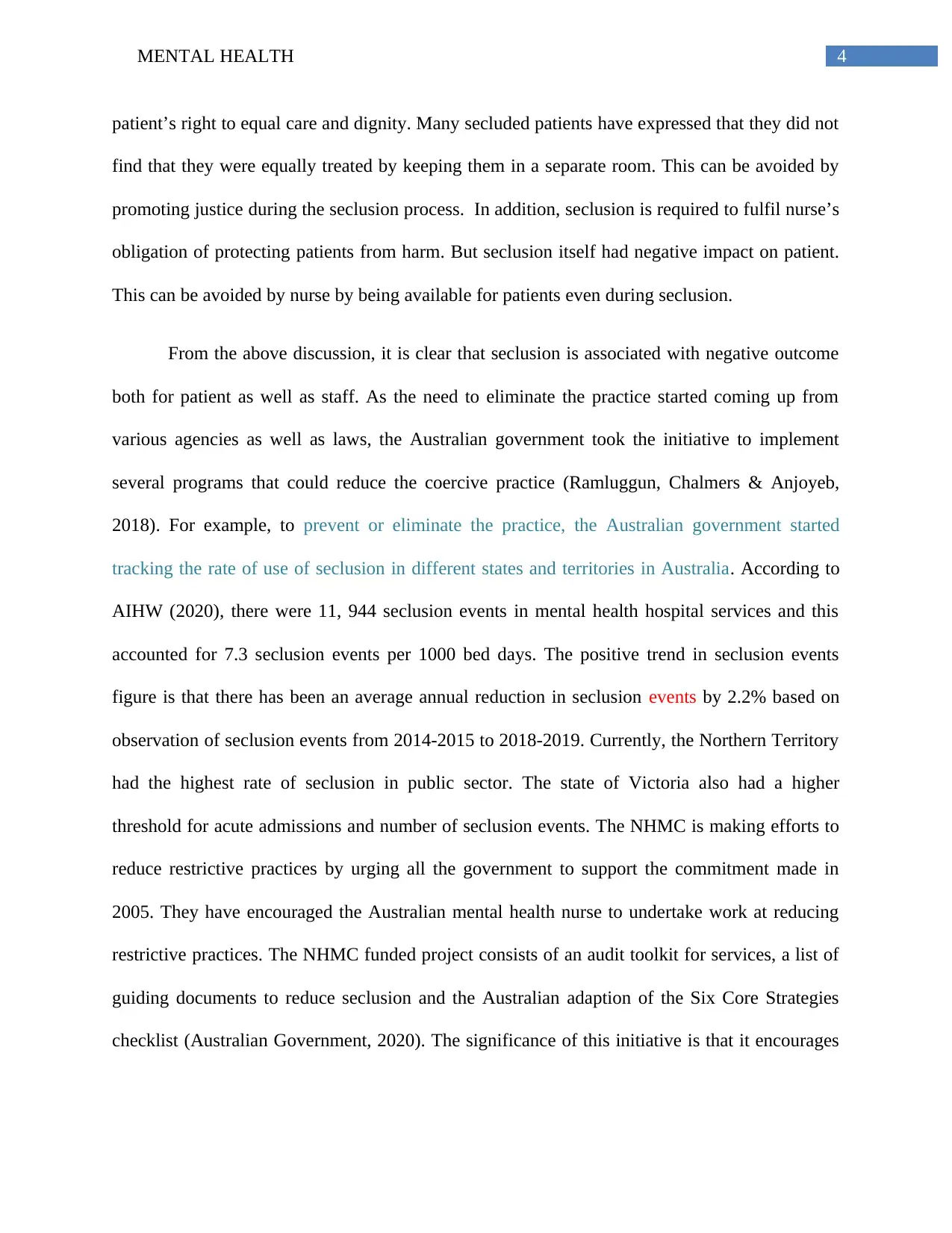
4MENTAL HEALTH
patient’s right to equal care and dignity. Many secluded patients have expressed that they did not
find that they were equally treated by keeping them in a separate room. This can be avoided by
promoting justice during the seclusion process. In addition, seclusion is required to fulfil nurse’s
obligation of protecting patients from harm. But seclusion itself had negative impact on patient.
This can be avoided by nurse by being available for patients even during seclusion.
From the above discussion, it is clear that seclusion is associated with negative outcome
both for patient as well as staff. As the need to eliminate the practice started coming up from
various agencies as well as laws, the Australian government took the initiative to implement
several programs that could reduce the coercive practice (Ramluggun, Chalmers & Anjoyeb,
2018). For example, to prevent or eliminate the practice, the Australian government started
tracking the rate of use of seclusion in different states and territories in Australia. According to
AIHW (2020), there were 11, 944 seclusion events in mental health hospital services and this
accounted for 7.3 seclusion events per 1000 bed days. The positive trend in seclusion events
figure is that there has been an average annual reduction in seclusion events by 2.2% based on
observation of seclusion events from 2014-2015 to 2018-2019. Currently, the Northern Territory
had the highest rate of seclusion in public sector. The state of Victoria also had a higher
threshold for acute admissions and number of seclusion events. The NHMC is making efforts to
reduce restrictive practices by urging all the government to support the commitment made in
2005. They have encouraged the Australian mental health nurse to undertake work at reducing
restrictive practices. The NHMC funded project consists of an audit toolkit for services, a list of
guiding documents to reduce seclusion and the Australian adaption of the Six Core Strategies
checklist (Australian Government, 2020). The significance of this initiative is that it encourages
patient’s right to equal care and dignity. Many secluded patients have expressed that they did not
find that they were equally treated by keeping them in a separate room. This can be avoided by
promoting justice during the seclusion process. In addition, seclusion is required to fulfil nurse’s
obligation of protecting patients from harm. But seclusion itself had negative impact on patient.
This can be avoided by nurse by being available for patients even during seclusion.
From the above discussion, it is clear that seclusion is associated with negative outcome
both for patient as well as staff. As the need to eliminate the practice started coming up from
various agencies as well as laws, the Australian government took the initiative to implement
several programs that could reduce the coercive practice (Ramluggun, Chalmers & Anjoyeb,
2018). For example, to prevent or eliminate the practice, the Australian government started
tracking the rate of use of seclusion in different states and territories in Australia. According to
AIHW (2020), there were 11, 944 seclusion events in mental health hospital services and this
accounted for 7.3 seclusion events per 1000 bed days. The positive trend in seclusion events
figure is that there has been an average annual reduction in seclusion events by 2.2% based on
observation of seclusion events from 2014-2015 to 2018-2019. Currently, the Northern Territory
had the highest rate of seclusion in public sector. The state of Victoria also had a higher
threshold for acute admissions and number of seclusion events. The NHMC is making efforts to
reduce restrictive practices by urging all the government to support the commitment made in
2005. They have encouraged the Australian mental health nurse to undertake work at reducing
restrictive practices. The NHMC funded project consists of an audit toolkit for services, a list of
guiding documents to reduce seclusion and the Australian adaption of the Six Core Strategies
checklist (Australian Government, 2020). The significance of this initiative is that it encourages
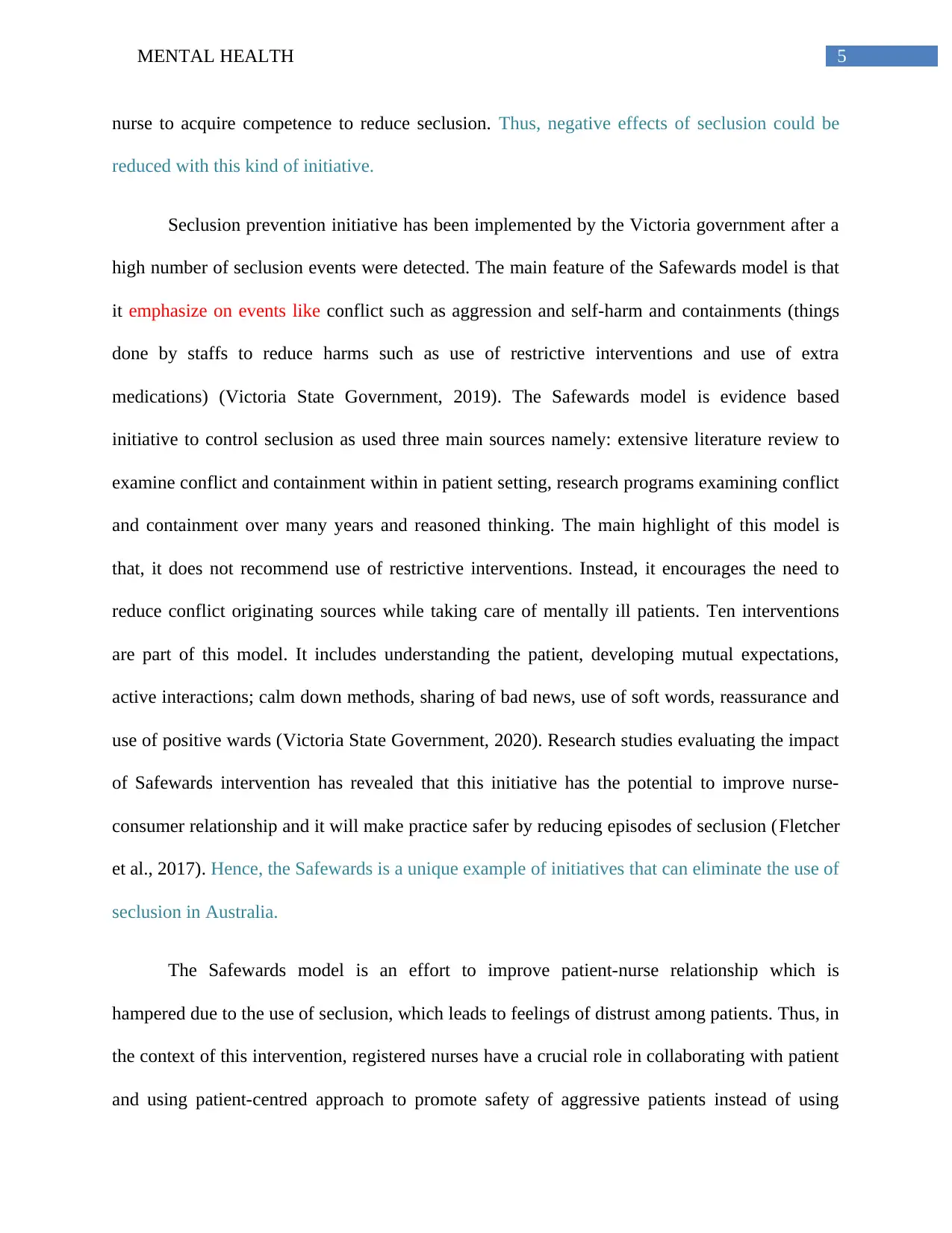
5MENTAL HEALTH
nurse to acquire competence to reduce seclusion. Thus, negative effects of seclusion could be
reduced with this kind of initiative.
Seclusion prevention initiative has been implemented by the Victoria government after a
high number of seclusion events were detected. The main feature of the Safewards model is that
it emphasize on events like conflict such as aggression and self-harm and containments (things
done by staffs to reduce harms such as use of restrictive interventions and use of extra
medications) (Victoria State Government, 2019). The Safewards model is evidence based
initiative to control seclusion as used three main sources namely: extensive literature review to
examine conflict and containment within in patient setting, research programs examining conflict
and containment over many years and reasoned thinking. The main highlight of this model is
that, it does not recommend use of restrictive interventions. Instead, it encourages the need to
reduce conflict originating sources while taking care of mentally ill patients. Ten interventions
are part of this model. It includes understanding the patient, developing mutual expectations,
active interactions; calm down methods, sharing of bad news, use of soft words, reassurance and
use of positive wards (Victoria State Government, 2020). Research studies evaluating the impact
of Safewards intervention has revealed that this initiative has the potential to improve nurse-
consumer relationship and it will make practice safer by reducing episodes of seclusion (Fletcher
et al., 2017). Hence, the Safewards is a unique example of initiatives that can eliminate the use of
seclusion in Australia.
The Safewards model is an effort to improve patient-nurse relationship which is
hampered due to the use of seclusion, which leads to feelings of distrust among patients. Thus, in
the context of this intervention, registered nurses have a crucial role in collaborating with patient
and using patient-centred approach to promote safety of aggressive patients instead of using
nurse to acquire competence to reduce seclusion. Thus, negative effects of seclusion could be
reduced with this kind of initiative.
Seclusion prevention initiative has been implemented by the Victoria government after a
high number of seclusion events were detected. The main feature of the Safewards model is that
it emphasize on events like conflict such as aggression and self-harm and containments (things
done by staffs to reduce harms such as use of restrictive interventions and use of extra
medications) (Victoria State Government, 2019). The Safewards model is evidence based
initiative to control seclusion as used three main sources namely: extensive literature review to
examine conflict and containment within in patient setting, research programs examining conflict
and containment over many years and reasoned thinking. The main highlight of this model is
that, it does not recommend use of restrictive interventions. Instead, it encourages the need to
reduce conflict originating sources while taking care of mentally ill patients. Ten interventions
are part of this model. It includes understanding the patient, developing mutual expectations,
active interactions; calm down methods, sharing of bad news, use of soft words, reassurance and
use of positive wards (Victoria State Government, 2020). Research studies evaluating the impact
of Safewards intervention has revealed that this initiative has the potential to improve nurse-
consumer relationship and it will make practice safer by reducing episodes of seclusion (Fletcher
et al., 2017). Hence, the Safewards is a unique example of initiatives that can eliminate the use of
seclusion in Australia.
The Safewards model is an effort to improve patient-nurse relationship which is
hampered due to the use of seclusion, which leads to feelings of distrust among patients. Thus, in
the context of this intervention, registered nurses have a crucial role in collaborating with patient
and using patient-centred approach to promote safety of aggressive patients instead of using
⊘ This is a preview!⊘
Do you want full access?
Subscribe today to unlock all pages.

Trusted by 1+ million students worldwide
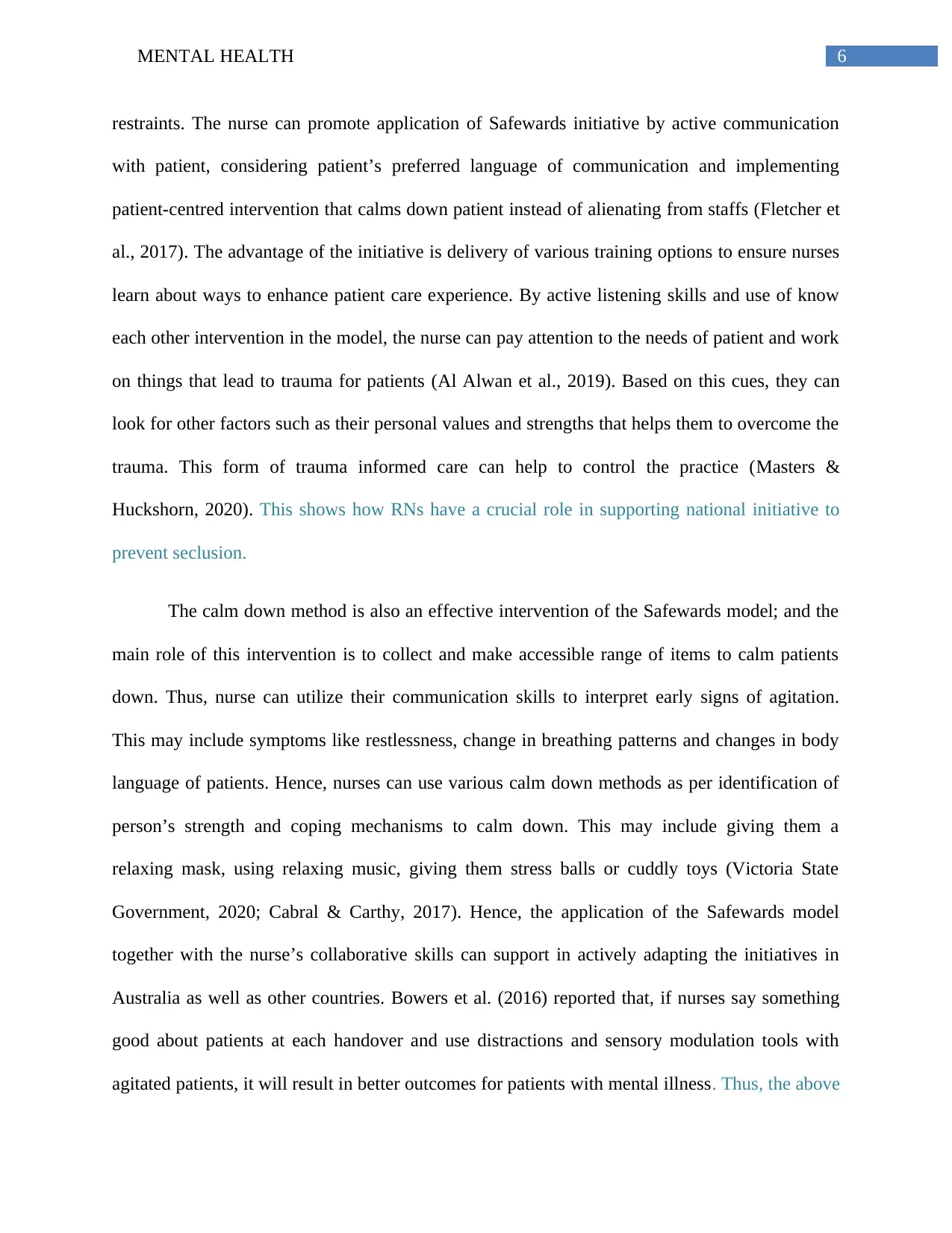
6MENTAL HEALTH
restraints. The nurse can promote application of Safewards initiative by active communication
with patient, considering patient’s preferred language of communication and implementing
patient-centred intervention that calms down patient instead of alienating from staffs (Fletcher et
al., 2017). The advantage of the initiative is delivery of various training options to ensure nurses
learn about ways to enhance patient care experience. By active listening skills and use of know
each other intervention in the model, the nurse can pay attention to the needs of patient and work
on things that lead to trauma for patients (Al Alwan et al., 2019). Based on this cues, they can
look for other factors such as their personal values and strengths that helps them to overcome the
trauma. This form of trauma informed care can help to control the practice (Masters &
Huckshorn, 2020). This shows how RNs have a crucial role in supporting national initiative to
prevent seclusion.
The calm down method is also an effective intervention of the Safewards model; and the
main role of this intervention is to collect and make accessible range of items to calm patients
down. Thus, nurse can utilize their communication skills to interpret early signs of agitation.
This may include symptoms like restlessness, change in breathing patterns and changes in body
language of patients. Hence, nurses can use various calm down methods as per identification of
person’s strength and coping mechanisms to calm down. This may include giving them a
relaxing mask, using relaxing music, giving them stress balls or cuddly toys (Victoria State
Government, 2020; Cabral & Carthy, 2017). Hence, the application of the Safewards model
together with the nurse’s collaborative skills can support in actively adapting the initiatives in
Australia as well as other countries. Bowers et al. (2016) reported that, if nurses say something
good about patients at each handover and use distractions and sensory modulation tools with
agitated patients, it will result in better outcomes for patients with mental illness. Thus, the above
restraints. The nurse can promote application of Safewards initiative by active communication
with patient, considering patient’s preferred language of communication and implementing
patient-centred intervention that calms down patient instead of alienating from staffs (Fletcher et
al., 2017). The advantage of the initiative is delivery of various training options to ensure nurses
learn about ways to enhance patient care experience. By active listening skills and use of know
each other intervention in the model, the nurse can pay attention to the needs of patient and work
on things that lead to trauma for patients (Al Alwan et al., 2019). Based on this cues, they can
look for other factors such as their personal values and strengths that helps them to overcome the
trauma. This form of trauma informed care can help to control the practice (Masters &
Huckshorn, 2020). This shows how RNs have a crucial role in supporting national initiative to
prevent seclusion.
The calm down method is also an effective intervention of the Safewards model; and the
main role of this intervention is to collect and make accessible range of items to calm patients
down. Thus, nurse can utilize their communication skills to interpret early signs of agitation.
This may include symptoms like restlessness, change in breathing patterns and changes in body
language of patients. Hence, nurses can use various calm down methods as per identification of
person’s strength and coping mechanisms to calm down. This may include giving them a
relaxing mask, using relaxing music, giving them stress balls or cuddly toys (Victoria State
Government, 2020; Cabral & Carthy, 2017). Hence, the application of the Safewards model
together with the nurse’s collaborative skills can support in actively adapting the initiatives in
Australia as well as other countries. Bowers et al. (2016) reported that, if nurses say something
good about patients at each handover and use distractions and sensory modulation tools with
agitated patients, it will result in better outcomes for patients with mental illness. Thus, the above
Paraphrase This Document
Need a fresh take? Get an instant paraphrase of this document with our AI Paraphraser
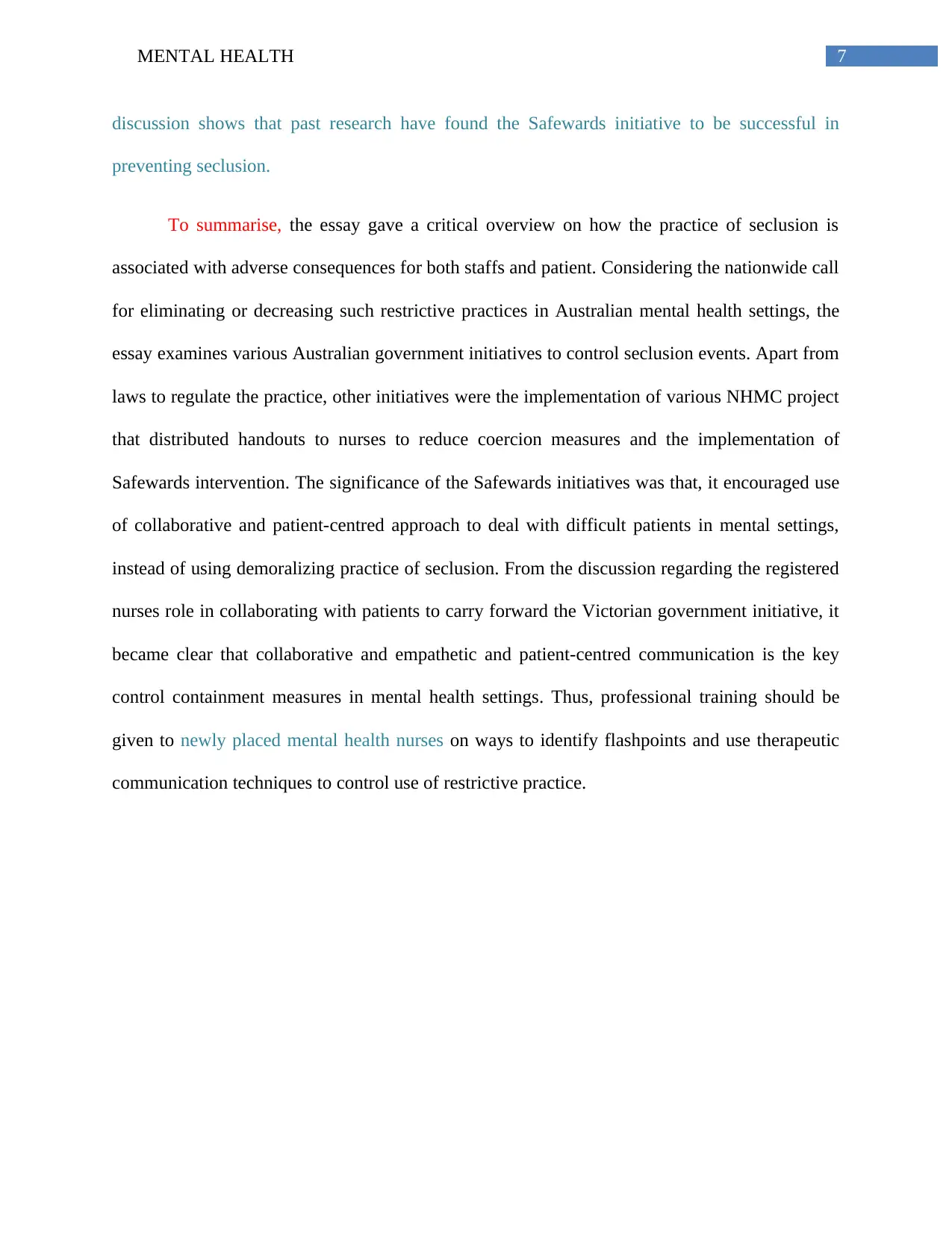
7MENTAL HEALTH
discussion shows that past research have found the Safewards initiative to be successful in
preventing seclusion.
To summarise, the essay gave a critical overview on how the practice of seclusion is
associated with adverse consequences for both staffs and patient. Considering the nationwide call
for eliminating or decreasing such restrictive practices in Australian mental health settings, the
essay examines various Australian government initiatives to control seclusion events. Apart from
laws to regulate the practice, other initiatives were the implementation of various NHMC project
that distributed handouts to nurses to reduce coercion measures and the implementation of
Safewards intervention. The significance of the Safewards initiatives was that, it encouraged use
of collaborative and patient-centred approach to deal with difficult patients in mental settings,
instead of using demoralizing practice of seclusion. From the discussion regarding the registered
nurses role in collaborating with patients to carry forward the Victorian government initiative, it
became clear that collaborative and empathetic and patient-centred communication is the key
control containment measures in mental health settings. Thus, professional training should be
given to newly placed mental health nurses on ways to identify flashpoints and use therapeutic
communication techniques to control use of restrictive practice.
discussion shows that past research have found the Safewards initiative to be successful in
preventing seclusion.
To summarise, the essay gave a critical overview on how the practice of seclusion is
associated with adverse consequences for both staffs and patient. Considering the nationwide call
for eliminating or decreasing such restrictive practices in Australian mental health settings, the
essay examines various Australian government initiatives to control seclusion events. Apart from
laws to regulate the practice, other initiatives were the implementation of various NHMC project
that distributed handouts to nurses to reduce coercion measures and the implementation of
Safewards intervention. The significance of the Safewards initiatives was that, it encouraged use
of collaborative and patient-centred approach to deal with difficult patients in mental settings,
instead of using demoralizing practice of seclusion. From the discussion regarding the registered
nurses role in collaborating with patients to carry forward the Victorian government initiative, it
became clear that collaborative and empathetic and patient-centred communication is the key
control containment measures in mental health settings. Thus, professional training should be
given to newly placed mental health nurses on ways to identify flashpoints and use therapeutic
communication techniques to control use of restrictive practice.
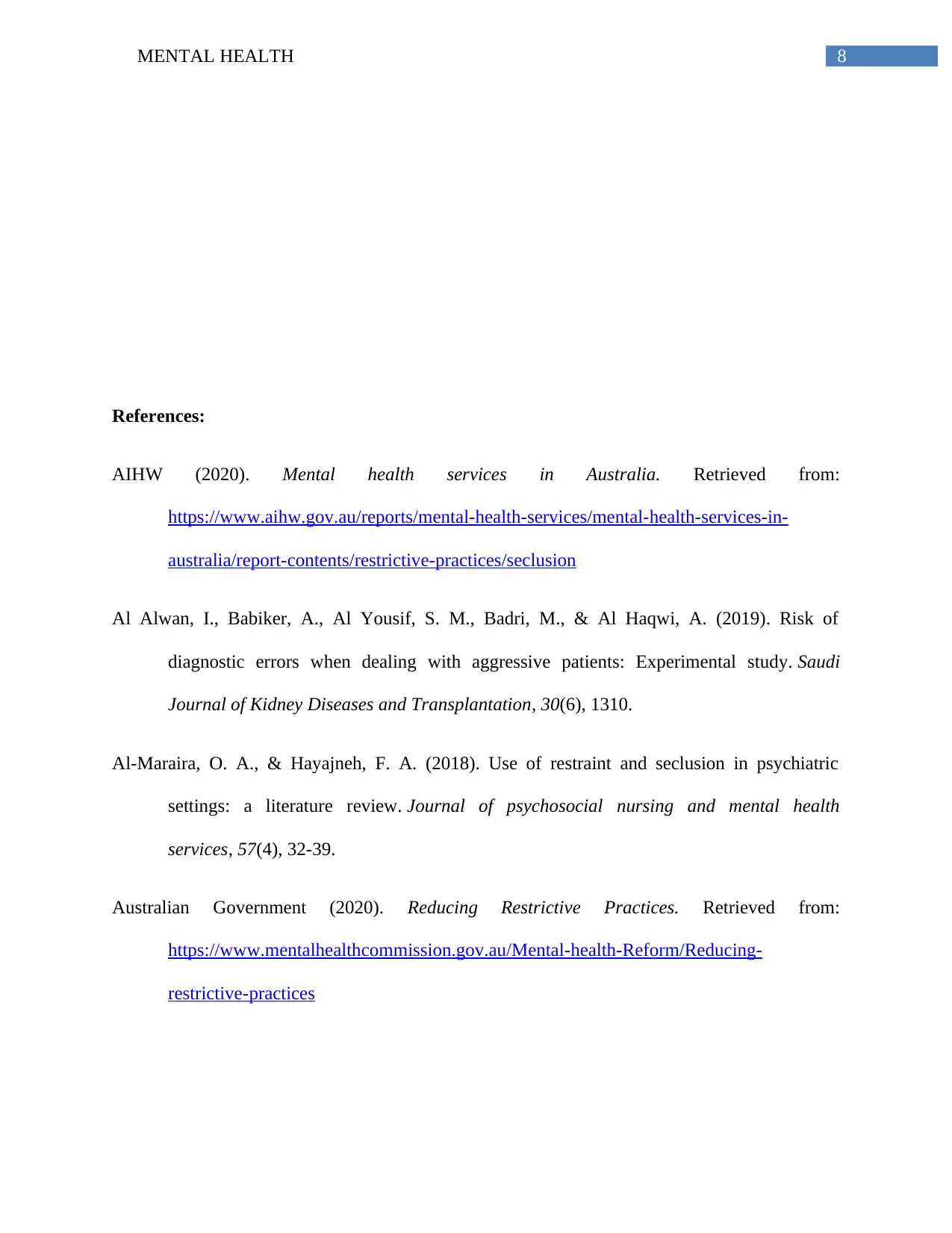
8MENTAL HEALTH
References:
AIHW (2020). Mental health services in Australia. Retrieved from:
https://www.aihw.gov.au/reports/mental-health-services/mental-health-services-in-
australia/report-contents/restrictive-practices/seclusion
Al Alwan, I., Babiker, A., Al Yousif, S. M., Badri, M., & Al Haqwi, A. (2019). Risk of
diagnostic errors when dealing with aggressive patients: Experimental study. Saudi
Journal of Kidney Diseases and Transplantation, 30(6), 1310.
Al-Maraira, O. A., & Hayajneh, F. A. (2018). Use of restraint and seclusion in psychiatric
settings: a literature review. Journal of psychosocial nursing and mental health
services, 57(4), 32-39.
Australian Government (2020). Reducing Restrictive Practices. Retrieved from:
https://www.mentalhealthcommission.gov.au/Mental-health-Reform/Reducing-
restrictive-practices
References:
AIHW (2020). Mental health services in Australia. Retrieved from:
https://www.aihw.gov.au/reports/mental-health-services/mental-health-services-in-
australia/report-contents/restrictive-practices/seclusion
Al Alwan, I., Babiker, A., Al Yousif, S. M., Badri, M., & Al Haqwi, A. (2019). Risk of
diagnostic errors when dealing with aggressive patients: Experimental study. Saudi
Journal of Kidney Diseases and Transplantation, 30(6), 1310.
Al-Maraira, O. A., & Hayajneh, F. A. (2018). Use of restraint and seclusion in psychiatric
settings: a literature review. Journal of psychosocial nursing and mental health
services, 57(4), 32-39.
Australian Government (2020). Reducing Restrictive Practices. Retrieved from:
https://www.mentalhealthcommission.gov.au/Mental-health-Reform/Reducing-
restrictive-practices
⊘ This is a preview!⊘
Do you want full access?
Subscribe today to unlock all pages.

Trusted by 1+ million students worldwide
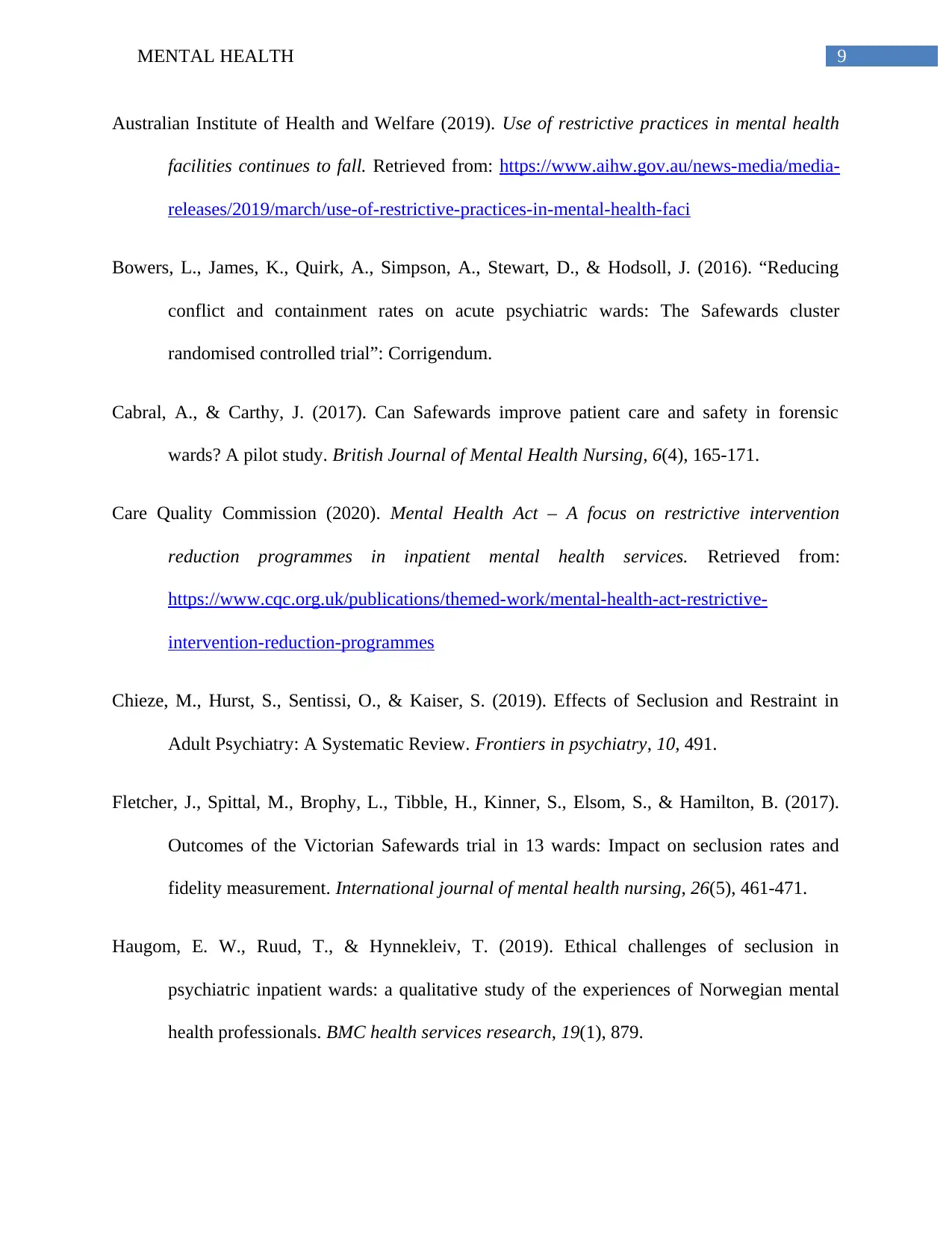
9MENTAL HEALTH
Australian Institute of Health and Welfare (2019). Use of restrictive practices in mental health
facilities continues to fall. Retrieved from: https://www.aihw.gov.au/news-media/media-
releases/2019/march/use-of-restrictive-practices-in-mental-health-faci
Bowers, L., James, K., Quirk, A., Simpson, A., Stewart, D., & Hodsoll, J. (2016). “Reducing
conflict and containment rates on acute psychiatric wards: The Safewards cluster
randomised controlled trial”: Corrigendum.
Cabral, A., & Carthy, J. (2017). Can Safewards improve patient care and safety in forensic
wards? A pilot study. British Journal of Mental Health Nursing, 6(4), 165-171.
Care Quality Commission (2020). Mental Health Act – A focus on restrictive intervention
reduction programmes in inpatient mental health services. Retrieved from:
https://www.cqc.org.uk/publications/themed-work/mental-health-act-restrictive-
intervention-reduction-programmes
Chieze, M., Hurst, S., Sentissi, O., & Kaiser, S. (2019). Effects of Seclusion and Restraint in
Adult Psychiatry: A Systematic Review. Frontiers in psychiatry, 10, 491.
Fletcher, J., Spittal, M., Brophy, L., Tibble, H., Kinner, S., Elsom, S., & Hamilton, B. (2017).
Outcomes of the Victorian Safewards trial in 13 wards: Impact on seclusion rates and
fidelity measurement. International journal of mental health nursing, 26(5), 461-471.
Haugom, E. W., Ruud, T., & Hynnekleiv, T. (2019). Ethical challenges of seclusion in
psychiatric inpatient wards: a qualitative study of the experiences of Norwegian mental
health professionals. BMC health services research, 19(1), 879.
Australian Institute of Health and Welfare (2019). Use of restrictive practices in mental health
facilities continues to fall. Retrieved from: https://www.aihw.gov.au/news-media/media-
releases/2019/march/use-of-restrictive-practices-in-mental-health-faci
Bowers, L., James, K., Quirk, A., Simpson, A., Stewart, D., & Hodsoll, J. (2016). “Reducing
conflict and containment rates on acute psychiatric wards: The Safewards cluster
randomised controlled trial”: Corrigendum.
Cabral, A., & Carthy, J. (2017). Can Safewards improve patient care and safety in forensic
wards? A pilot study. British Journal of Mental Health Nursing, 6(4), 165-171.
Care Quality Commission (2020). Mental Health Act – A focus on restrictive intervention
reduction programmes in inpatient mental health services. Retrieved from:
https://www.cqc.org.uk/publications/themed-work/mental-health-act-restrictive-
intervention-reduction-programmes
Chieze, M., Hurst, S., Sentissi, O., & Kaiser, S. (2019). Effects of Seclusion and Restraint in
Adult Psychiatry: A Systematic Review. Frontiers in psychiatry, 10, 491.
Fletcher, J., Spittal, M., Brophy, L., Tibble, H., Kinner, S., Elsom, S., & Hamilton, B. (2017).
Outcomes of the Victorian Safewards trial in 13 wards: Impact on seclusion rates and
fidelity measurement. International journal of mental health nursing, 26(5), 461-471.
Haugom, E. W., Ruud, T., & Hynnekleiv, T. (2019). Ethical challenges of seclusion in
psychiatric inpatient wards: a qualitative study of the experiences of Norwegian mental
health professionals. BMC health services research, 19(1), 879.
Paraphrase This Document
Need a fresh take? Get an instant paraphrase of this document with our AI Paraphraser
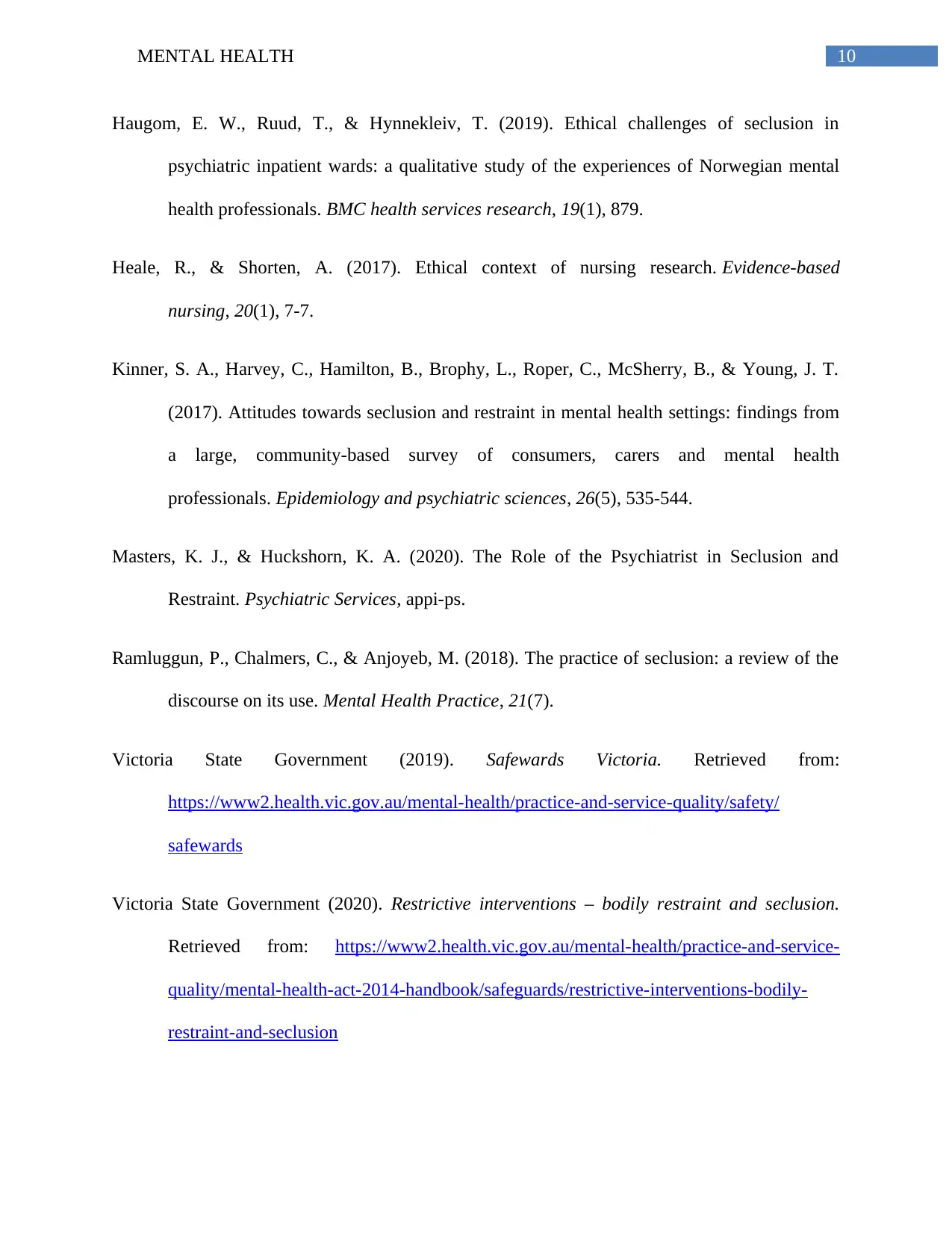
10MENTAL HEALTH
Haugom, E. W., Ruud, T., & Hynnekleiv, T. (2019). Ethical challenges of seclusion in
psychiatric inpatient wards: a qualitative study of the experiences of Norwegian mental
health professionals. BMC health services research, 19(1), 879.
Heale, R., & Shorten, A. (2017). Ethical context of nursing research. Evidence-based
nursing, 20(1), 7-7.
Kinner, S. A., Harvey, C., Hamilton, B., Brophy, L., Roper, C., McSherry, B., & Young, J. T.
(2017). Attitudes towards seclusion and restraint in mental health settings: findings from
a large, community-based survey of consumers, carers and mental health
professionals. Epidemiology and psychiatric sciences, 26(5), 535-544.
Masters, K. J., & Huckshorn, K. A. (2020). The Role of the Psychiatrist in Seclusion and
Restraint. Psychiatric Services, appi-ps.
Ramluggun, P., Chalmers, C., & Anjoyeb, M. (2018). The practice of seclusion: a review of the
discourse on its use. Mental Health Practice, 21(7).
Victoria State Government (2019). Safewards Victoria. Retrieved from:
https://www2.health.vic.gov.au/mental-health/practice-and-service-quality/safety/
safewards
Victoria State Government (2020). Restrictive interventions – bodily restraint and seclusion.
Retrieved from: https://www2.health.vic.gov.au/mental-health/practice-and-service-
quality/mental-health-act-2014-handbook/safeguards/restrictive-interventions-bodily-
restraint-and-seclusion
Haugom, E. W., Ruud, T., & Hynnekleiv, T. (2019). Ethical challenges of seclusion in
psychiatric inpatient wards: a qualitative study of the experiences of Norwegian mental
health professionals. BMC health services research, 19(1), 879.
Heale, R., & Shorten, A. (2017). Ethical context of nursing research. Evidence-based
nursing, 20(1), 7-7.
Kinner, S. A., Harvey, C., Hamilton, B., Brophy, L., Roper, C., McSherry, B., & Young, J. T.
(2017). Attitudes towards seclusion and restraint in mental health settings: findings from
a large, community-based survey of consumers, carers and mental health
professionals. Epidemiology and psychiatric sciences, 26(5), 535-544.
Masters, K. J., & Huckshorn, K. A. (2020). The Role of the Psychiatrist in Seclusion and
Restraint. Psychiatric Services, appi-ps.
Ramluggun, P., Chalmers, C., & Anjoyeb, M. (2018). The practice of seclusion: a review of the
discourse on its use. Mental Health Practice, 21(7).
Victoria State Government (2019). Safewards Victoria. Retrieved from:
https://www2.health.vic.gov.au/mental-health/practice-and-service-quality/safety/
safewards
Victoria State Government (2020). Restrictive interventions – bodily restraint and seclusion.
Retrieved from: https://www2.health.vic.gov.au/mental-health/practice-and-service-
quality/mental-health-act-2014-handbook/safeguards/restrictive-interventions-bodily-
restraint-and-seclusion
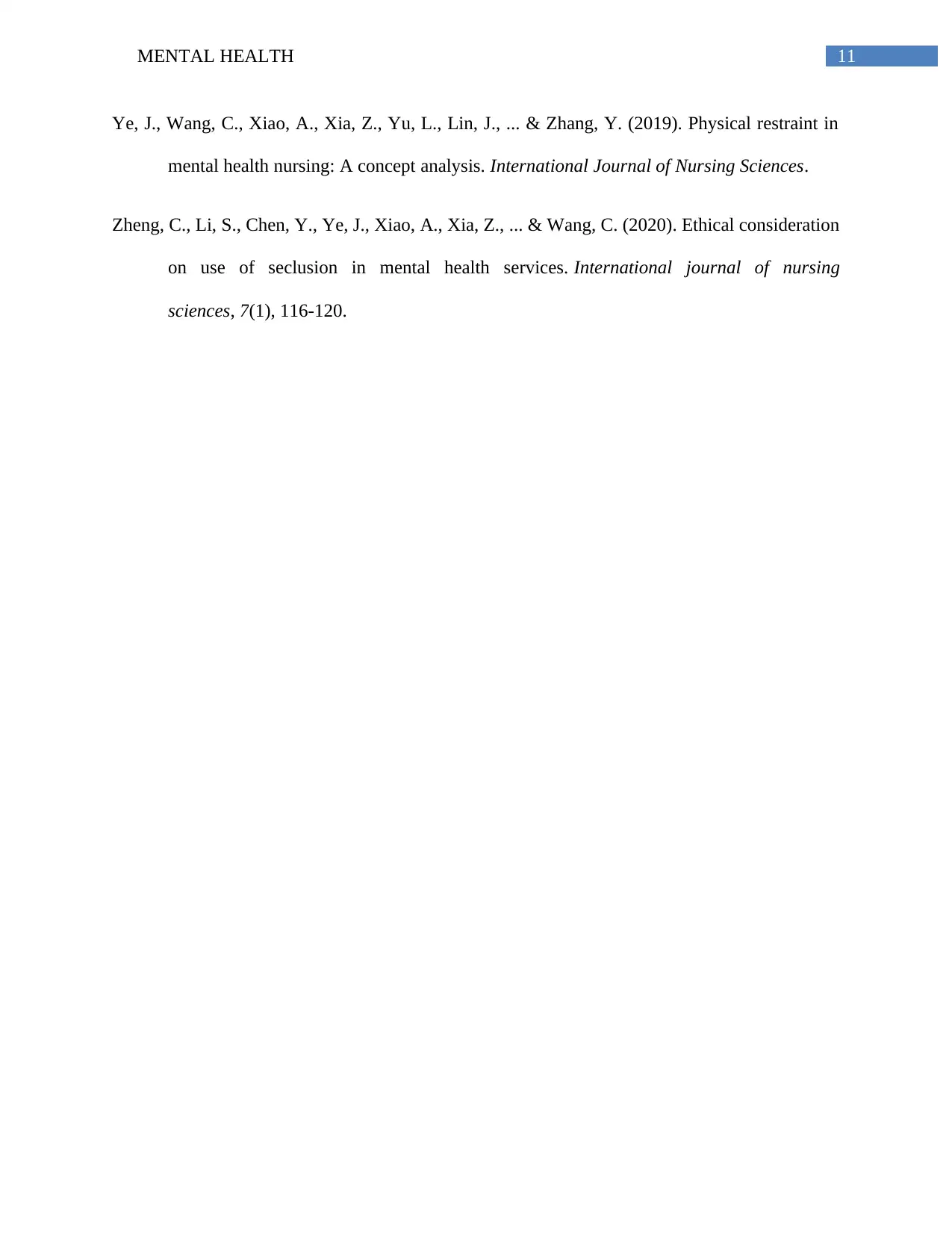
11MENTAL HEALTH
Ye, J., Wang, C., Xiao, A., Xia, Z., Yu, L., Lin, J., ... & Zhang, Y. (2019). Physical restraint in
mental health nursing: A concept analysis. International Journal of Nursing Sciences.
Zheng, C., Li, S., Chen, Y., Ye, J., Xiao, A., Xia, Z., ... & Wang, C. (2020). Ethical consideration
on use of seclusion in mental health services. International journal of nursing
sciences, 7(1), 116-120.
Ye, J., Wang, C., Xiao, A., Xia, Z., Yu, L., Lin, J., ... & Zhang, Y. (2019). Physical restraint in
mental health nursing: A concept analysis. International Journal of Nursing Sciences.
Zheng, C., Li, S., Chen, Y., Ye, J., Xiao, A., Xia, Z., ... & Wang, C. (2020). Ethical consideration
on use of seclusion in mental health services. International journal of nursing
sciences, 7(1), 116-120.
⊘ This is a preview!⊘
Do you want full access?
Subscribe today to unlock all pages.

Trusted by 1+ million students worldwide
1 out of 12
Related Documents
Your All-in-One AI-Powered Toolkit for Academic Success.
+13062052269
info@desklib.com
Available 24*7 on WhatsApp / Email
![[object Object]](/_next/static/media/star-bottom.7253800d.svg)
Unlock your academic potential
Copyright © 2020–2025 A2Z Services. All Rights Reserved. Developed and managed by ZUCOL.





